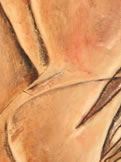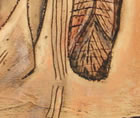 |
|
||||
| Previous | Gallery | Next |
 |
||||||||
 |
||||||||
 |
 |
 |
||||||
 |
||||||||
 |
 |
 |
||||||
MALE DYNAMIC FIGURE COLORS used in this piece are Indiana Rose, ground clay, gray, black, Naples Yellow Red, raw umber and dirt from Sedona , Arizona . Sedona , Arizona is a metaphysical paradise with its infamous vortexes. These vortexes are swirling centers of energy, passageways to powerful transformational energy zones. They are spiritual areas where Native Americans often build medicine wheels and hold sacred ceremonies. BACKGROUND is eggshell. TEXTURING is smooth with gypsum applied in a “wave” motion. Edges of piece are uniquely accomplished by notching. SIZE is 12”H x 12”W CULTURAL INSPIRATION: This Dynamic Figure painting is from Deaf Adder Gorge and is believed to be at least 10,000 years old. Aboriginal informants said the Mimi spirits, Dreamtime ancestors of the Aborigines, created it. The Dynamic Figures often portray human beings in complex apparel. This particular representation portrays a male figure wearing a tasseled headdress. There is also a long bustle with a feather-like panel attached to a hair belt. Waterwash is invading this area, damaging one of the hands. The other hand is holding two boomerangs. Waterwash is a real problem. With the torrential rainy season, water has undermined some of the area rock art. There is an urgent need to save these artistically decorated rock paintings for posterity. It is difficult to accomplish this type of art, considering the canvas—a rough and rocky surface. The body is well proportioned, showing a muscular form. These exquisite Dynamic Figures are often depicted with many cultural elements such as headdresses, bags, spears, hafted axes and goosewing fans. Many are seen leaping through the air in graceful fighting and hunting poses. On Mornington Island , men in circumcision ceremonies wore ceremonial headdress. They were made from human-hair string and paperbark and decorated with emu feathers and ochres. Besides using bark and feathers, many everyday objects, still made and used in northern Australia were made from fiber. Every Aboriginal person was skilled in the use of fiber craft. Such cherished objects as coiled baskets and mats, eel traps, and string bags were all made from skilled fiber craft techniques passed down over hundreds of years. In northeast Arnhem Land large ceremonial “ngainmara” mats were used in fertility rituals. |